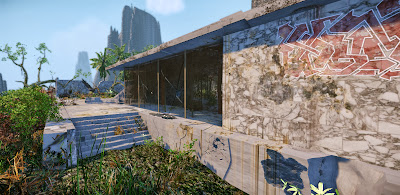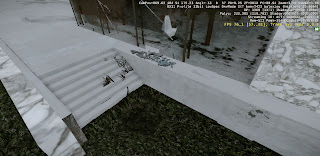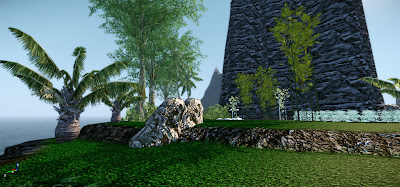https://www.dropbox.com/s/1i2xr57jj4fu087/BENV2423_balexiou_theisland_V03.cry
https://www.dropbox.com/s/mnmeqmlxv19h68s/BENV2423_balexiou_theisland.rar
Monday, 18 November 2013
Reflection on week 12 lecture
The visiting lecturer, Jeremy Harkins, talked to us about real-time environments and real-time data and how this is used in modern day projects to give the user a simulated experience of a building environment. He talked about the current project at Barangaroo and how using real-time data his company were able to integrate all models of the proposed building into one real-time environment.
Strategy for demonstrating state of decay
The strategy I have followed to depict decay and structural failure in my building (Barcelona Pavilion) is that of human abandonment due to a plague which wiped out most of human life. Vegetation however continues to grow causing significant structural damage such as cracking, movement and direct damage from large trees falling onto walls and roofs. Glass has a long lifespan but is subject to breaking and cracking under structural pressure and extreme weather conditions. The roof of my building will also crack, leak and break into pieces exposing the understructure to further damage. Dirt, weathering and plant infestation will change the physical appearance of the materials making the building almost unrecognisable as compared to its original maintained state.
Reflection on week 11 lecture
In this lecture we were introduced to further techniques such as blend layers to add realistic detail to our decaying buildings. An interesting fact which Russell mentioned was that moss in the southern hemisphere only grows on the southern sides of buildings and the reverse in the northern hemisphere.
5 movie trailers
Depicts a massive and devastating environmental event that would precipitate a similar scenario to the abandonment of buildings for a long period of time.
Last man on earth after strange plague survives in decaying urban landscape which is dramatically portrayed visually.
A film about the extreme effects of nuclear devastation in which buildings are completely destroyed in contrast to the slow decay of abandonment.
TV series which directly addresses the subject of abandonment with historical example and computer aided imagery.
Another post nuclear scenario, with stark cinematography that depicts buildings and structures in states of decay and abandonment.
Reflection on week 10 lecture
The lecture was on ''abandonment'', in other words, buildings whose occupants no longer maintain and use the building. We were introduced to a plug-in for 3ds Max called "rayfire" which can assist in breaking up an object in various ways. We were also shown slides of the Hurricane Katrina's devastation and the way it left buildings in New Orleans. One particular slide which intrigued me was of a house which had a clear flood level line showing just how far underwater it had been.
Images of progress
Statement of direction
Overall, I'm trying to simulate the general structural failings of the building over a long period of non-human habitation (100 years). Cracks will appear in the concrete and stone through the upward pressures of plants and trees, earth movement and water inundation. Steel columns supporting the roof warp under pressure and glass may crack or break into pieces through these same pressures and long term weathering.
3 sketches of failing structural systems and reference images
Vegetation overtaking built environment.
Vegetation and structural decay on brick and concrete structure.
Street in Pompei after almost 2000 years.
Sketch of roof and how it might crack with supporting steel columns warping.
Vegetation and falling trees attacking structure.
Concrete and glass cracking.
Sunday, 27 October 2013
Reflection on week 9 lecture
This weeks lecture was titled "forensic architecture" and looked into the uses of different materials and construction systems and how they might fail over time. The lecture included some short videos showing the step by step process of a building being made using pre-cast panels and steel frames stacked on top of each other (Hemeroscopium house). Another one was a time lapse video of the new world trade centre being built. Slides of the devastation caused by the Christchurch earthquake were shown.
Research into materials
Marble:
Marble is a non-foliated metamorphic rock that forms through the metamorphism of limestone. Very durable hard stone. The lifespan of marble is exceptional, thanks to its durability. Marble is one of the oldest building materials, used by the ancient Greeks and Romans. Used in floors, sculptures and other architecture.
Concrete:
Concrete is a mixture of aggregates (sand, gravel, and crushed stone), other additives, cement and water. It is a stable durable material with high compressive strength, withstanding inward pressures but low in tensile strength (stretching forces). Reinforced steel (rebar) is added to the concrete to give slabs tensile load (keeping it tense). Concrete can be used for slabs walls and roofs.
It is a highly durable material and will not rust, rot or burn. Typical life expectancy of concrete is approximately 100 years. Limestone, used for cement, is one of the most
abundant minerals on earth.
Glass:
Glass is made from a mixture of sand and silicates, and fired in a kiln. Glass is a very sustainable material, made from abundant raw materials and can be recycled over and over. Glass can last indefinitely.
Marble is a non-foliated metamorphic rock that forms through the metamorphism of limestone. Very durable hard stone. The lifespan of marble is exceptional, thanks to its durability. Marble is one of the oldest building materials, used by the ancient Greeks and Romans. Used in floors, sculptures and other architecture.
Concrete:
Concrete is a mixture of aggregates (sand, gravel, and crushed stone), other additives, cement and water. It is a stable durable material with high compressive strength, withstanding inward pressures but low in tensile strength (stretching forces). Reinforced steel (rebar) is added to the concrete to give slabs tensile load (keeping it tense). Concrete can be used for slabs walls and roofs.
Glass is made from a mixture of sand and silicates, and fired in a kiln. Glass is a very sustainable material, made from abundant raw materials and can be recycled over and over. Glass can last indefinitely.
Reflection on week 8 lecture
The week 8 lecture was on "life after people", looking at what would happen to the human built environment 100 years after humans cease to exist. The brief for experiment 2 was outlined and the three buildings we will be using introduced. We will be looking at how different materials collapse, breakdown and decay. Some interesting slides were shown of Priyat, the town that was abandoned after the Chernobyl nuclear disaster in 1986 and also of Hashima Island, Japan a coal mining facility, which has now been abandoned for 40 years.
House in Bordeaux
Designed by Rem Koolhass and constructed 1994-1998 in Bordeaux, France. Specifically built for a family and someone who has a disability. Built over three levels with the lower level built into the rocky hillside. Materials consist of cement, glass and aluminium.
Rudin House
Designed by Herzog & de Meuron in 1996 and located in a village in France. House is primarily made of concrete, sitting on a suspended slab. Has a gable roof and large windows.
Barcelona Pavilion
Designed by Ludwig Mies van der Rohe, and opened in 1929. Important building in modern architecture, uses exotic materials such as marble, red onyx (type of stone), sits on a travertine (form of limestone) base, uses cruciform steel columns, and also glass.
Monday, 16 September 2013
Reflection on week 7 lecture
This week's lecture explained about the "track view" function on CryEngine. This is used to create cinematic scenes by setting up cameras, sequences and other effects. We were also told about a 3D visual programming language called Grasshopper, which is similar to the nodes and flow graphs used in CryEngine. Russell mentioned that familiarity with this software is sought after in the field of architecture.
Reflection on week 6 lecture
The lecture was on "movement", showing examples of movie trailers. Some examples of dramatic movie trailers shown were that of Stanley Kubrick's "2001: A Space Odyssey" and Steven Speilberg "Jaws". These trailers are made to give viewers a taste of the full length feature and often only a few minutes in length. I will use a similar dramatic short video to create a trailer for my island in CryEngine. We were also told about the new version of CryEngine which was just recently released.
Sunday, 15 September 2013
Reflection on week 5 lecture
This week's lecture was on "the subliminal". Subtle messages and images, which may not even be visually clear at first glance, are often used in advertising, logos and other visual media. Some examples shown in the lecture, which I had never noticed before, were the arrow embedded in the FedEx and the polar bear in the Toblerone logos. This subtle revealment and concealment of images or messages can be incorporated into my CryEngine island environment.
Strategy for the concealing and the revealing of letter / number combination
On a macro scale, from a distant aerial perspective, my letter/number combination (U9) takes a number of forms. The main island formation is in the shape of a U, with the number 9 appearing within this formation. There are 9 small separate islands scattered around the U-shaped landmass. There are also 9 rocky peaks on one end of the island. As we approach the main bay from the air there are 6 large rocks in a U-shape, and next to them, a small island in the shape of an inverted 9. On the tallest island outside the main landmass, on its snowy peak, stones protrude from the snow in the shape of a 9, and above it are smaller rocks in the shape of a U. As we approach the micro scale, on one of the beaches within the bay, some rocks, barrels, buckets and lobster traps are left on the beach making up the letter and number U9. On the micro scale on a flat terrace above the helicopter base located on a small shed and illuminated by a neon light is the shed ID which is none other than.....U9.
Reflection on week 4 lecture
The lecture was on "the sublime" in Western painting and digital imaging. The images that caught my attention were one of Caspar David Freidrich's "Wanderer above a sea of fog" and JMW Turner's "Fisherman at sea". In both these paintings the sea dominates as a powerful and dangerous presence and which humans are at the mercy of. A video of a digital 3D model of Mount Everest also caught my attention as I can envision how it was created using a program similar to CryEngine.
Thursday, 12 September 2013
Reflection on week 3 lecture
This lecture was on the "picturesque" and showed slides of landscapes which were drawn and painted by the ''Grand Tourists", upper class English people who travelled continental Europe between 17th and 19th century. One image which struck me was that of a painting of the Colosseum in Rome from an aerial perspective, which was the result of an imaginative visualisation, as there was no other means of gaining such a perspective at the time.
Subscribe to:
Posts (Atom)

















































